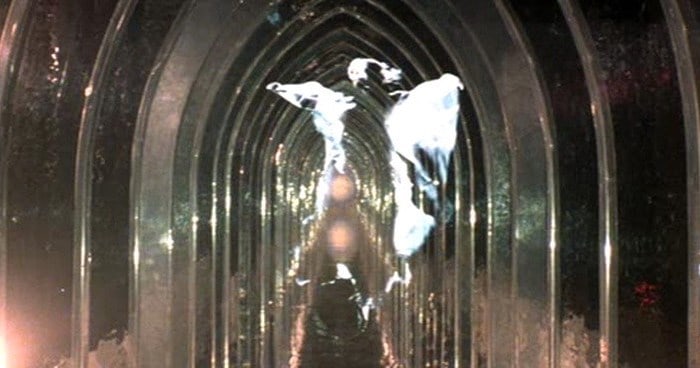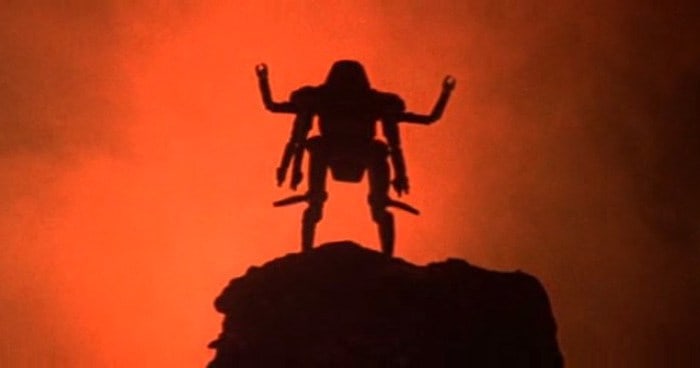This post contains spoilers for The Black Hole, a film released 40 years ago. So if it’s still on your watchlist because life keeps getting in the way, or whatever, consider yourself warned.
Back in 1979, Disney lost its damn mind and made The Black Hole. It was the studio’s first-ever PG-rated movie (because of the utterances of “hell” and “damn”) and its most expensive production up to that time. As an artifact, it’s fascinating, but as an actual movie-watching experience it’s tragically dull. That’s why I’m here to give you the tl;dr version so you can be in the know about this embarrassing piece of Disney history without sacrificing 90 minutes of your life to the cause. You’re welcome.
The premise of The Black Hole is pretty simple: in the year 2130, the USS Palomino discovers the long-lost USS Cygnus hovering at the edge of a black hole while on a deep space exploration mission. Partly motivated by sheer curiosity, partly motivated by the fact that the father of Palomino crew member Kate McCrae (Yvette Mimieux) was part of this long-lost mission, they decide to investigate.
Aboard the Cygnus, they find only Dr. Hans Reinhardt (Maximilian Schell), a mysterious scientist obsessed with the black hole, alone save for an army of faceless androids and a personal assistant/henchman robot named Maximillian, who is in the final stages of planning a voyage into the black hole. (Maximillian and Reinhardt’s clothes are both bright red, by the way, in case you were wondering if the film cashes in on all that Cold War-era fearmongering.) Reinhardt claims that he has been by himself on the ship for decades, having stayed behind to study the black hole while the remaining crew, including McCrae’s father, embarked on a return journey.
While it may not be the most dynamic or original setup, the real issue is not so much concept as execution. Plenty of uninspired premises manage to be entertaining anyway, but The Black Hole has no understanding of things like building tension or character motivation, so it’s a real slog. I’ve seen the film twice now, and even still the six crew members of the Palomino are stored in my head as V.I.N.CENT (the mission robot and MVP, more on this later), “Norman Bates in Space” (because Disney decided that the sort of star power its biggest film ever required was the guy from Psycho), “ESP Lady” (aka Dr. McCrae, also more on this later), and three other utterly forgettable dudes, one of whom looks vaguely like Jeff Goldblum.
The “plot,” if we can even really call it that, clunks along without the slightest semblance of fanfare or nuance. The villainous Reinhardt is clearly devious from the word “go,” and the details of his evil plot aren’t uncovered so much as gracelessly revealed. Overall, the film is perhaps best described as a series of Deus ex machinas. While exploring the ship, V.I.N.CENT runs into B.O.B., an earlier model of V.I.N.CENT who accompanied the Cygnus mission and somehow managed to survive clear efforts to, erm, retire him.
B.O.B. reveals everything. That army of faceless androids? The lobotomized crew of the Cygnus, reprogrammed by Reinhardt into a mindless workforce after they mutinied against him, lead by McCrae’s father. V.I.N.CENT is in an entirely different part of the ship from the rest of the crew when he learns this information, but thankfully he has an ESP link to Dr. McCrae and is able to pass the information along ASAP. Even in the way these scenes are filmed, it’s akin to the Rey/Kylo Ren Force bond as seen in The Last Jedi, only if instead of the emo man-child formerly known as Ben Solo being on the other end of the line, Rey had a mental link with BB-8. The Black Hole does not even attempt to make sense of or rationalize this bond; it just simply is.
Anyway, moving on, the Palomino crew decides to get the hell out of Dodge, but not before Norman Bates gets murdered, not that anyone seems to really care. They end up getting sucked into the black hole with Reinhardt anyway. After a trippy we’re-being-sucked-into-a-Black-Hole sequence that’s the less inspired lovechild of 2001‘s “Star Gate” sequence and Willy Wonka and the Chocolate Factory‘s tunnel of nightmares, it’s revealed that the black hole leads directly to actual Hell, complete with fire and brimstone. Only because the crew members of the Palomino are pure of heart (or something; I’ve got to guess here because the film explains absolutely nothing about its baffling conclusion) they are saved from Dante’s space inferno by the ghost of Jesus or whoever the dude pictured below is, and end up elsewhere in the vastness of space, headed directly for an unidentified, presumably habitable, planet in the distance.

Reinhardt, meanwhile, meets a suitably horrific end, merging with Maximillian into a monstrous hybrid who seems to be instantaneously elected king of Space Hell or something along those lines, because this is the last we see of him:

All things considered, the ending of The Black Hole feels like an obvious set-up for a second installment that never happened because the film faceplanted at the box office (shocking, I know.) While some press around the time of the film’s release indicates that Disney was attempting to appeal to a more adult audience, the studio also put in a huge effort to market the film to children, including a deal with Mego Toys that saw the manufacturer producing six million tie-in toys, including action figures and models of the Palomino. In everything from plot to identifying an intended audience, The Black Hole is so confused, it’s practically comical. At least, it is for me, regarding it in hindsight. For the unsuspecting generation of sci-fi loving children traumatized by the film in the exact same way I expect Tom Hooper’s upcoming Cats will traumatize the children of today, it’s probably not quite so funny, but I digress.
The Black Hole is not worth watching, but that does not mean it is utterly devoid of redeeming qualities. The tense, swirly theme composed by John Barry of James Bond scoring fame is a definite bop, even if the score elsewhere gets a bit derivative, and there are a handful of pretty beautiful shots scattered throughout the film, even if the visual effects, on the whole, aren’t really all that much to write home about, even for 1979.
While the plotting is terrible, the uninspired screenplay is, at least in some places, terrible in an entertaining sort of way. As a card-carrying member of the mad-as-balls scientist club, Reinhardt has such zingers as “the word ‘impossible’ is only found in the dictionary of fools,” while V.I.N.CENT, an obvious rip-off of both R2-D2 and C-3PO at the same time, regularly steals the show. Admittedly, this does not really mean much in context, but there’s something weirdly game-changing about knowing that Disney tried to match the success of Star Wars with a film that prominently features a robot quoting Cicero (“rashness is the characteristic of youth, prudence that of mellowed age, and discretion the better part of valor”).
The Disney of today is on top of the entertainment world, a vaguely terrifying behemoth that very much looks to be creeping towards total domination of the entertainment landscape. As such, the studio would probably rather we all just forgot about the more mortifying stuff it’s done in the past, including the bad life choices it made in the ’70s, which is really all the more reason we should endeavor to remember. So while you really don’t need to see The Black Hole (seriously, spare yourself), it’s worth remembering that it happened. And that it’s pretty damn embarrassing.
The post Remember that Time Disney Lost Its Damn Mind and Made ‘The Black Hole’? appeared first on Film School Rejects.
0 comments:
Post a Comment